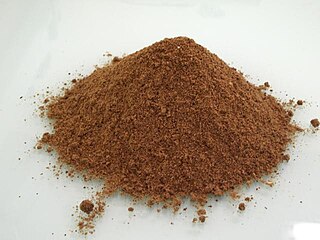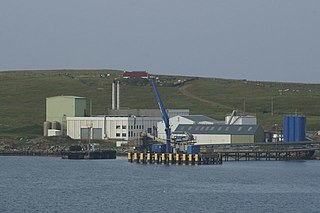Fish meal
Commercial product made from fish to feed farm animals From Wikipedia, the free encyclopedia
Commercial product made from fish to feed farm animals From Wikipedia, the free encyclopedia
Fish meal, sometimes spelt fishmeal, is a commercial product made from whole wild-caught fish, bycatch, and fish by-products to feed farm animals, e.g., pigs, poultry, and farmed fish.[1] Because it is calorically dense and cheap to produce, fishmeal has played a critical role in the growth of factory farms and the number of farm animals it is possible to breed and feed.[citation needed]

Fishmeal takes the form of powder or cake. This form is obtained by drying the fish or fish trimmings, and then grinding it. If the fish used is a fatty fish it is first pressed to extract most of the fish oil.[1][2]
The production and large-scale use of fishmeal are controversial. The lucrative market for fishmeal as a feed encourages corporate fisheries not to limit their yields of by-catch (from which fish meal is made), and thus leads to depletion of ecosystems, environmental damage, and the collapse of local fisheries.[citation needed] Its role in facilitating the breeding and over-feeding of millions of pigs and chickens on factory farms has also been criticized by animal rights and animal welfare groups.[citation needed] Manufacturers of fishmeal counter that fishmeal's role in the feeding and breeding of millions of farm animals leads to the production of more food and the feeding of millions of people around the world.[citation needed]
Fish byproducts have been used historically to feed poultry, pigs, and other farmed fish. A primitive form of fishmeal is mentioned in The Travels of Marco Polo at the beginning of the 14th century: "they accustom their cattle, cows, sheep, camels, and horses to feed upon dried fish, which being regularly served to them, they eat without any sign of dislike." The use of herring as an industrial raw material started as early as about 800 AD in Norway; a very primitive process of pressing the oil out of herring by means of wooden boards and stones was employed.[2]
Prior to 1910, fish meal was primarily used as fertilizer, at least in the UK.[2]
Fish meal is now primarily used as a protein supplement in compound feed.[2][3] As of 2010, about 56% of fish meal was used to feed farmed fish, about 20% was used in pig feed, about 12% in poultry feed, and about 12% in other uses, which included fertilizer.[1]
The cost of 65% protein fishmeal has varied between around $385 to $554 per ton since 2000, which is about two to three times the price of soybean meal.[1]
The rising demand for fish, as people in the developed world turn away from red meat and toward other sources of meat protein, has increased demand for farmed fish, with farmed fish accounting for half the fish consumed worldwide as of 2016.[4] Demand for fish meal has increased accordingly, but harvests are regulated and supply cannot expand.[1][4] This has led to a trend towards use of other ingredients such as soybean meal, cottonseed meal, leftovers from processing from corn and wheat, legumes, and algae, and an increase in research to find alternatives to fish meal and alternate strategic uses (for instance, in the growth phase, after newborn fish are established).[1][4][5]
Fishmeal can be made from almost any type of seafood, but is generally manufactured from wild-caught, small marine fish that contain a high percentage of bones and oil.[1] Previously, these fish have been considered unsuitable for direct human consumption,[1] but more recent research indicates the vast majority of fishmeal made from whole wild-caught fish is made from fish suitable for direct human consumption.[6] Other sources of fishmeal are from bycatch and byproducts of trimmings made during processing (fish waste or offal) of various seafood products destined for direct human consumption.[1]
The main fish sources by country are:[1][2][3]
It takes 4 to 5 tons of fish to produce one ton of fish meal; about 6 million tons of fish are harvested each year solely to make fish meal.[1]
Fish meal production is a significant contributor of over-fishing, and risks pushing fisheries beyond their replacement rate. Some areas of the world, such as Western Africa, have seen a large increase in fish meal production which in turn is hurting local fisheries and driving fisheries into collapse.[7][8]


Fishmeal is made by cooking, pressing, drying, and grinding of fish or fish waste into a solid. Most of the water and some or all of the oil is removed. Four or five tonnes of fish are needed to manufacture one tonne of dry fishmeal.[1]
Of the several ways of making fishmeal from raw fish, the simplest is to let the fish dry out in the sun before grinding and pressing. This method is still used in some parts of the world where processing plants are not available, but the end product is poor quality in comparison with ones made by modern methods.
Today, all industrial fish meal is made by the following processes:[2]
Cooking: The fish are moved through a commercial cooker — a long, steam-jacketed cylinder — by a screw conveyor. This is a critical stage in preparing the fishmeal, as incomplete cooking means the liquid from the fish cannot be pressed out satisfactorily and overcooking makes the material too soft for pressing. No drying occurs in the cooking stage.
Pressing: The cooked fish is compressed inside a perforated tube, expelling some of its liquids, leaving "press cake". Water content is reduced from 70% to about 50% and oil down to 4%.
Drying: The press cake is dried by tumbling inside a heated drum. Under-drying may result in the growth of molds or bacteria; over-drying can cause scorching and reduction in the meal's nutritional value.
Two alternative methods of drying are used:
Grinding: The dried meal is ground[how?] to remove any lumps or bone particles.
Any complete diet must contain some protein, but the nutritional value of the protein relates directly to its amino acid composition and digestibility. High-quality fishmeal normally contains between 60% and 72% crude protein by weight. Typical diets for fish may contain from 32% to 45% total protein by weight.[9]
Unmodified fish meal can spontaneously combust from heat generated by oxidation of the polyunsaturated fatty acids in the meal. In the past, factory ships have sunk because of such fires. That danger has been eliminated by adding antioxidants to the meal.[1]
As of 2001, ethoxyquin was the most commonly used antioxidant, usually in the range 200–1000 mg/kg.[2] There has been some speculation that ethoxyquin in pet foods might be responsible for multiple health problems. To date, the U.S. Food and Drug Administration has only found a verifiable connection between ethoxyquin and buildup of protoporphyrin IX in the liver, as well as elevations in liver-related enzymes in some animals, but with no known health consequences from these effects. In 1997, the Center for Veterinary Medicine asked pet food manufacturers to voluntarily limit ethoxyquin levels to 75 ppm until further evidence is reported. However, most pet foods that contain ethoxyquin have never exceeded this amount. Ethoxyquin has been shown to be slightly toxic to fish.[citation needed]
Though it has been approved for use in foods in the US, and as a spray insecticide for fruits, ethoxyquin has not been thoroughly tested for its carcinogenic potential. Ethoxyquin has long been suggested to be a possible carcinogen, and a very closely related chemical, 1,2-dihydro-2,2,4-trimethylquinoline, has been shown to have carcinogenic activity in rats, and a potential for carcinogenic effect to fishmeal prior to storage or transportation.[citation needed]
Globally, most of the fishmeal products are characterised by possessing a certain level of plastics pollution.[10] A recent study showed that a wide range of plastics content was found, ranging from 0 to 526.7 n/kg in samples from 26 different fishmeal products, from 11 countries on four continents and Antarctica.[10]
Seamless Wikipedia browsing. On steroids.
Every time you click a link to Wikipedia, Wiktionary or Wikiquote in your browser's search results, it will show the modern Wikiwand interface.
Wikiwand extension is a five stars, simple, with minimum permission required to keep your browsing private, safe and transparent.